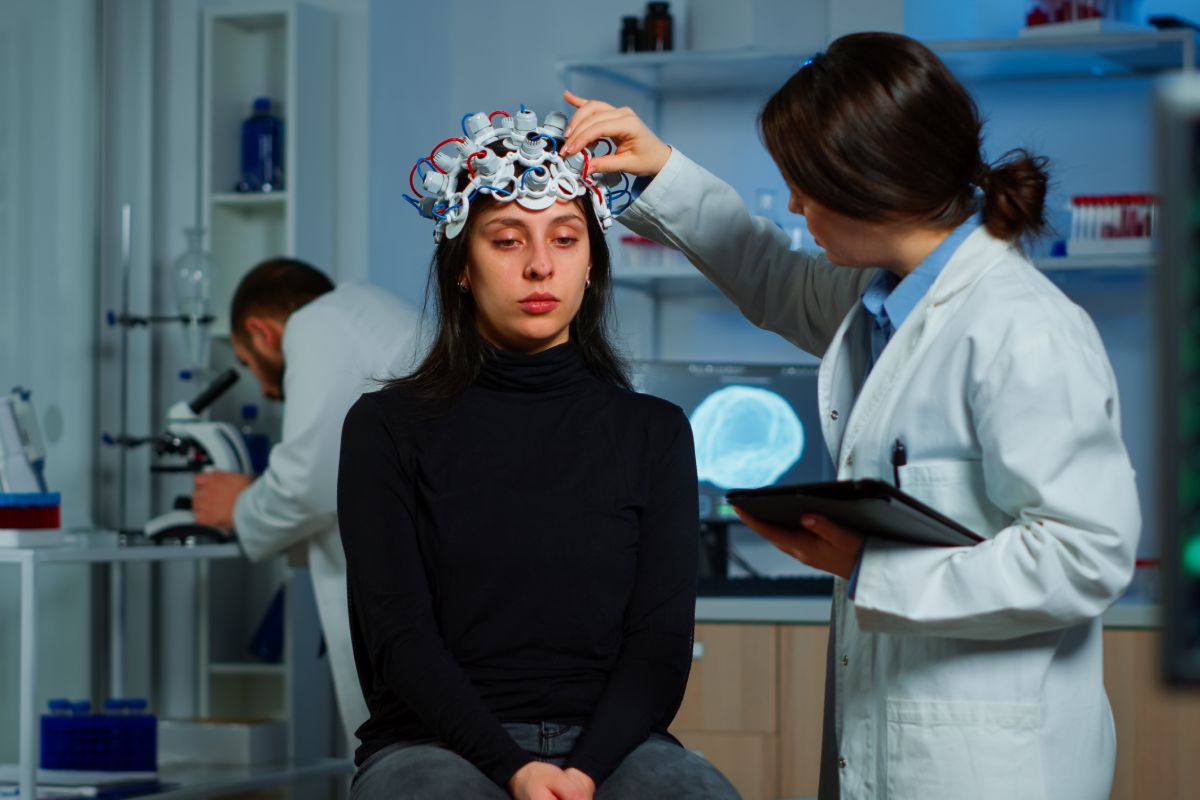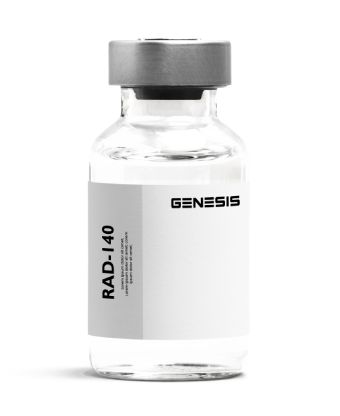Semaglutide injection is used to treat type 2 diabetes. It is used together with diet and exercise to help control your blood sugar. This medicine is also used to lower the risk of heart attack, stroke, or death in patients with type 2 diabetes and heart or blood vessel disease.
$59.50
Improves muscle mass and strength [1-3]
Fights cancer [4-6]
Improves brain health [7-12]
Promotes weight loss [14]
Improves sexual health [15-18]
Treats benign prostatic hyperplasia (BPH) [19-20]
Improves bone health [21-23]
RAD-140, also known as Testolone, is a selective androgen receptor modulator (SARM). It is an investigational compound that binds to androgen receptors in the body, specifically targeting skeletal muscle and bone tissue. RAD-140 is designed to selectively stimulate the androgen receptors in these tissues, leading to anabolic effects without causing the negative side effects typically associated with traditional anabolic agents and steroids.
RAD-140 has gained attention in the fitness and bodybuilding communities due to its potential to enhance muscle growth, burn fat, and muscle loss increase strength, and improve athletic performance. It is believed to have a high anabolic effect and a relatively low androgenic effect, making it appealing for individuals seeking the benefits of anabolic substances while minimizing unwanted side effects.
However, it’s important to note that RAD-140 is still under investigation and has not been approved by regulatory authorities for medical or therapeutic use. As with any performance-enhancing substance, it is crucial to understand the potential risks and consult with a healthcare professional before considering its use.
RAD-140, or Testolone, works by selectively binding to androgen receptors in vital organs of the body. Androgen receptors are primarily found in skeletal muscle and bone tissue, as well as other organs such as the liver and prostate. When RAD-140 binds to these receptors, it activates them, leading to various physiological effects.
One of the main effects of RAD-140 is its anabolic activity in muscle tissue. By binding to androgen receptors in skeletal muscle, RAD-140 stimulates protein synthesis, which is the process by which cells in muscle tissues can build muscle proteins and repair muscle fibers. This increased protein synthesis results in enhanced growth of muscles and recovery.
RAD-140 has also been shown to increase bone mineral density, which can have positive effects on bone health and improve cognitive function and strength. By binding to androgen receptors in bone tissue, it can promote bone growth and help prevent age-related and bone density loss.
In addition to its anabolic effects, RAD-140 may also have neuroprotective properties. It has shown potential in protecting neurons and promoting neuronal cell survival. This makes it an area of interest for research in neurodegenerative conditions such as Alzheimer’s disease.
It’s worth noting that RAD-140 is considered a SARM, meaning it selectively targets androgen receptors in specific tissues, such as muscle and bone, while minimizing the activation of androgen receptors in other tissues, such as the prostate. This selective binding is believed to contribute to RAD-140’s ability to provide anabolic benefits without the unwanted side effects commonly associated with anabolic steroids.
However, it’s important to remember that RAD-140 is still undergoing research and has not been approved for medical use by regulatory authorities. The exact mechanisms and long-term effects of RAD-140 are still being studied, and further research is needed to fully understand its potential benefits and risks.
IMG
When used responsibly and within recommended dosage guidelines, RAD-140 is generally considered safe. However, it is important to consult with a healthcare professional before starting any new supplement.

RAD-140, also known as Testolone, is a SARM that is widely used in the bodybuilding and fitness community for its ability to enhance lean muscle mass, and strength. It was initially developed as a potential treatment for muscle wasting conditions, such as cancer cachexia and age-related skeletal muscle tissue loss.
One of the main mechanisms through which RAD-140 exerts its effects is by binding to androgen receptors in the body. Androgen receptors are found in various tissues, including skeletal muscle, bone, and the brain. When RAD-140 binds to these receptors, it enhances their activity, leading to an increase in muscle protein synthesis and muscle mass.
In preclinical studies, RAD-140 has demonstrated anabolic effects on muscle tissue. It has been shown to promote the increasing lean muscle mass, increase lean body mass, and part growth, increase muscle strength, and improve endurance and stamina. These effects make it an attractive compound for athletes and bodybuilders looking to enhance their physical performance muscle building and gain lean muscle mass.
In addition to its anabolic effects, RAD-140 also has potential neuroprotective properties. Studies have shown that it can protect brain cells from damage and promote the survival and growth of neurons. This suggests that RAD-140 may have potential applications in the treatment of neurodegenerative diseases, such as Alzheimer’s and Parkinson’s.
Furthermore, RAD-140 has been found to increase bone mineral density, which is important for building muscles maintaining strong and healthy bones. It has also been shown to enhance fat loss and improve insulin sensitivity, which can have positive effects on reduced body fat composition, muscle loss and overall health.
In summary, RAD-140 is a promising compound that has shown potential in promoting muscle growth, increasing strength, protecting brain cells, and improving bone health. However, it is important to note that further research is needed to fully understand the effects and potential side effects of RAD-140, as well as its long-term safety profile.
RAD-140, also known as Testolone, is a SARM that has shown promising potential in fighting cancer. While RAD-140 is primarily known for its ability to promote muscle growth and enhance athletic performance, recent studies have revealed its anti-cancer properties.
RAD-140 works by selectively targeting and activating the androgen receptors in cancer cells. Androgen receptors are proteins that play a crucial role in regulating cell growth and survival. By binding to these receptors, RAD-140 inhibits the growth of cancer cells and triggers apoptosis, or programmed cell death, leading to the destruction of cancerous cells.
Research has demonstrated the efficacy of RAD-140 in various types of cancer, including breast cancer, prostate cancer, and colon cancer. In a study published in the journal Cancer Letters, RAD-140 was found to inhibit the growth of breast cancer cells by suppressing their proliferation and inducing cell death. Another study published in the Journal of Medicinal Chemistry showed that RAD-140 exhibited potent anti-proliferative effects on prostate cancer cells by inhibiting their growth and reducing tumor size.
Furthermore, RAD-140 has shown potential as a treatment for androgen receptor-positive triple-negative breast cancer, a particularly aggressive and difficult-to-treat form of breast cancer. In a study published in the journal Molecular Cancer Therapeutics, RAD-140 was found to significantly inhibit the growth of androgen receptor-positive triple-negative cancer cells, suggesting its potential as a targeted therapy for this subtype of breast cancer.
These findings highlight the potential of RAD-140 as a promising therapeutic agent in the fight against cancer. Further research is needed to fully understand its mechanisms of action and explore its efficacy in different types of cancer.

RAD-140, also known as Testolone, is a SARM that has gained attention for its potential in improving brain health. While RAD-140 is primarily known for its ability to enhance muscle growth and athletic performance, emerging research suggests that it may also have neuroprotective and cognitive-enhancing effects.
RAD-140 exerts its effects in the brain by selectively targeting and activating androgen receptors, which are present in various regions of the central nervous system. By binding to these receptors, RAD-140 can stimulate the release of certain neuroprotective factors and promote neuronal survival and function.
Studies have shown promising results regarding the potential of RAD-140 in improving cognitive function and brain health. In a study published in the European Journal of Pharmacology, RAD-140 was found to enhance memory and learning abilities in animal models of Alzheimer’s disease (1). The study demonstrated that RAD-140 administration improved cognitive performance and reduced the accumulation of amyloid-beta plaques, which are characteristic features of Alzheimer’s disease.
Furthermore, RAD-140 has shown potential in protecting brain cells against neurodegenerative conditions. In a study published in the Journal of Molecular Cell Biology, RAD-140 was found to activate mitochondrial retrograde signaling, a cellular pathway that plays a crucial role in maintaining mitochondrial function and preventing neuronal damage (2). By activating this pathway, RAD-140 exhibited neuroprotective effects and enhanced the survival of brain cells.
These findings suggest that RAD-140 may hold promise as a therapeutic agent for improving brain health and combating neurodegenerative diseases. However, further research is needed to fully understand the mechanisms underlying its neuroprotective effects and explore its potential clinical applications.

RAD-140, also known as Testolone, is a SARM that has gained attention for its potential in promoting muscle gains and weight loss. While RAD-140 is primarily known for its ability to enhance muscle growth and athletic performance, emerging research suggests that it may also have beneficial effects on body composition and metabolism.
RAD-140 exerts its effects on weight loss by selectively targeting and activating androgen receptors in various tissues, including muscle and fat cells. By binding to these receptors, RAD-140 can increase muscle protein synthesis and promote the development of more lean mass and muscle mass. This can result in increasing muscle mass gains and an overall increase in metabolic rate, as muscle tissue requires more energy to build muscle maintain compared to fat tissue.
In other research conducted in a study published in the journal Hormone and Metabolic Research, RAD-140 demonstrated its potential for promoting weight loss and reducing fat mass (1). The study examined the effects of RAD-140 on excess lean body mass and fat in obese male rats and found that treatment with RAD-140 resulted in significant reductions in both lean body mass, fat percentage, weight and fat mass, along with improvements in insulin sensitivity.
Furthermore, RAD-140 may also have an impact on lipid metabolism, which can contribute to both fat burning from excess body fat and both body weight and excess fat loss. In a study published in the journal Cell Metabolism, RAD-140 was shown to increase the expression of genes involved in lipid metabolism in skeletal muscle (2). This suggests that RAD-140 may enhance the utilization of stored fat as an energy source, leading to improved fat oxidation and weight loss.
While these findings indicate the potential of RAD-140 in promoting weight loss, it’s important to note that more research is needed to fully understand its mechanisms of action and evaluate its safety and efficacy in humans. As with any performance-enhancing substance, it should be used under the guidance of a healthcare professional.

RAD-140, also known as Testolone, is a SARM that has been investigated for its potential to improve sexual health. Androgens play a crucial role in sexual function, and RAD-140 has shown promising effects on enhancing sexual performance and addressing certain sexual health concerns.
RAD-140 works by selectively binding to androgen receptors in various tissues, including those involved in sexual function. By activating these receptors, RAD-140 can mimic the effects of testosterone, leading to improved sexual health outcomes.
In a study published in the Journal of Endocrinology, researchers explored the effects of RAD-140 on sexual behavior in male rats. The results showed that RAD-140 treatment significantly increased sexual motivation and performance, including an increase in mounting behavior and the number of successful copulatory events.
Furthermore, RAD-140 may also have potential benefits for individuals with certain sexual health conditions. A study published in the journal Sexual Medicine investigated the effects of RAD-140 in a rat model of erectile dysfunction. The findings demonstrated that RAD-140 administration improved erectile function by increasing nitric oxide production and improving blood flow to the erectile tissues.
While these preliminary studies suggest the potential of RAD-140 in improving sexual health, it is important to note that further research is needed, especially in human subjects, to fully understand its effectiveness, safety, and long-term effects.
It is essential to consult with a healthcare professional before considering the use of RAD-140 or any other performance-enhancing substances to address sexual health concerns.
RAD-140, also known as Testolone, is a SARM that has shown potential in the treatment of benign prostatic hyperplasia (BPH). BPH is a non-cancerous enlargement of the prostate gland that can cause urinary symptoms and impact quality of life. RAD-140 may offer therapeutic benefits for individuals with BPH by targeting androgen receptors in the prostate gland.
Research on the effects of RAD-140 in treating BPH is still limited, but early findings indicate its potential efficacy. In a study published in the Journal of Medicinal Chemistry, researchers evaluated the effects of RAD-140 on prostate size in a rodent model of BPH (1). The results demonstrated that RAD-140 treatment significantly reduced prostate weight and decreased the size of prostate tissue, indicating potential anti-hyperplasic effects.
Additionally, a study published in the journal Prostate examined the impact of RAD-140 on prostate-specific antigen (PSA) levels in a rat model of BPH (2). PSA is a marker commonly used to assess prostate health, and elevated levels are often associated with BPH. The study found that RAD-140 administration significantly reduced PSA levels, suggesting a potential therapeutic effect on BPH.
While these preliminary studies show promise, further research and clinical trials is necessary to determine the long-term safety and efficacy of RAD-140 for BPH treatment. It is important to note that RAD-140 is still under investigation and should only be used under the guidance of a healthcare professional.
If you suspect you have BPH or are seeking treatment options, it is essential to consult with a healthcare provider who can provide appropriate medical advice and guidance.

RAD-140, also known as Testolone, is a selective androgen receptor modulator (SARM) that has shown promise in improving bone health. Maintaining strong and healthy bones is essential for overall well-being and to prevent conditions like osteoporosis. RAD-140 may offer potential benefits for bone health by targeting androgen receptors in bone tissue.
Although research on the effects of RAD-140 specifically on both bone density and joint health is limited, studies on other SARMs and androgen receptor agonists provide insights into its potential benefits. One study published in the Journal of Bone and Mineral Research investigated the effects of a different SARM, S-40503, on bone mineral density (BMD) in postmenopausal women (1). The results showed a significant increase in lumbar spine BMD in women who received S-40503 compared to the placebo group, indicating a positive impact on bone health.
Another study published in the Journal of Bone and Mineral Research explored the effects of an androgen receptor agonist, dihydrotestosterone (DHT), on bone formation in mice (2). The findings revealed that DHT administration increased bone formation and improved bone strength, highlighting the potential of androgen receptor activation in promoting bone health.
While there is limited direct evidence on RAD-140’s effects on bone health, its mechanism of action as an androgen receptor modulator suggests the potential for positive outcomes. However, further research is necessary to evaluate RAD-140’s specific impact on bone health and to determine its long-term safety and efficacy.
It is important to note that RAD-140 is still under investigation, and its use should only be pursued under the guidance of a healthcare professional.
To maximize the benefits of RAD-140 while minimizing potential side effects, it is important to follow a well-structured dosage and cycle plan. While individual needs may vary, a typical RAD-140 dosage ranges from XX to XX milligrams per day, divided into XX doses. It is advisable to start with a lower dosage and gradually increase it to assess your tolerance and response.
A typical RAD-140 cycle lasts around XX to XX weeks, followed by a post-cycle therapy (PCT) to help restore natural hormone levels. It is crucial to consult with a healthcare professional or a knowledgeable fitness expert before starting RAD-140 to ensure a safe and effective regimen.
RAD-140, like other selective androgen receptor modulators (SARMs), is still being researched, and its potential side effects are not yet fully understood. However, based on available information and anecdotal reports, some potential side effects associated with RAD-140 use may include:
Testosterone Suppression: RAD-140 can suppress natural testosterone production. This can lead to hormonal imbalances and potential symptoms such as decreased libido, fatigue, and mood changes. It is recommended to undergo post-cycle therapy (PCT) after RAD-140 use to help restore natural testosterone levels.
Androgenic Side Effects: RAD-140 has strong androgenic properties, which means it may cause androgenic side effects such as acne, oily skin, and increased facial or body hair growth. These effects are more likely to occur in individuals who are prone to androgen-related side effects.
Cardiovascular Risks: Androgens, including RAD-140, can affect lipid profiles by decreasing high-density lipoprotein (HDL) cholesterol and increasing low-density lipoprotein (LDL) cholesterol. This can potentially increase the risk of cardiovascular problems. Monitoring lipid levels and maintaining a healthy lifestyle is essential during RAD-140 use.
Liver Toxicity: While there is limited data available on RAD-140’s impact on liver function, some SARMs have shown potential liver toxicity in animal studies. It is important to use RAD-140 responsibly and avoid exceeding recommended dosages or prolonged use to minimize the risk of liver damage.
Other Possible Side Effects: Other potential side effects that have been reported anecdotally include headaches, insomnia, and changes in blood pressure. However, further research is needed to establish the frequency and severity of these side effects.
It is crucial to note that individual experiences with RAD-140 may vary, and some users may not experience any significant side effects. To minimize risks, it is recommended to use RAD-140 under the supervision of a healthcare professional, follow recommended dosages, and undergo regular health check-ups.
It is essential to prioritize safety and make informed decisions when considering the use of RAD-140 or any other performance-enhancing substances sports supplements. Consulting with a healthcare professional before starting any new supplement or compound is highly advised.
What does RAD-140 do?
RAD-140, also known as Testolone, is a Selective Androgen Receptor Modulator (SARM) that binds to androgen receptors in the body. It promotes anabolic effects, leading to increased muscle mass, enhanced endurance, accelerated fat loss, and improved recovery. RAD-140 is popular among athletes and fitness enthusiasts for its ability to optimize physical performance and body composition.
How to take RAD-140?
The recommended dosage and administration of RAD-140 can vary depending on individual goals and tolerance levels. However, a common approach is to take RAD-140 orally as a liquid or capsule. It is advisable to start with a lower dosage, such as 10mg per day, and gradually increase it if needed. It is crucial to follow the instructions provided by the manufacturer or consult with a healthcare professional or fitness expert for personalized guidance.
Does RAD-140 increase testosterone levels?
Yes, RAD-140 has the potential to increase testosterone levels. As a SARM, it selectively binds to androgen receptors in muscle and bone tissues, mimicking the effects of testosterone. This binding stimulates anabolic activity, promoting muscle growth and strength gains. However, it’s important to note that individual responses may vary, and it’s always advisable to consult with a healthcare professional for personalized advice.
When to take RAD-140?
The timing of RAD-140 administration can depend on factors such as personal preference, daily schedule, and workout routine. Some individuals prefer to take RAD-140 in the morning, while others divide the dosage throughout the day. It is generally recommended to take RAD-140 with meals to enhance absorption and minimize the potential for stomach discomfort. However, it’s essential to follow the specific instructions provided by the manufacturer or consult with a healthcare professional for personalized recommendations.
How long does RAD-140 stay in your system?
The half-life of RAD-140 is approximately 16 to 20 hours. This means that it takes approximately 16 to 20 hours for half of the compound to be eliminated from the body. Generally, RAD-140 will be mostly cleared from the system within a few days after discontinuation. However, it’s important to note that individual factors, such as metabolism and dosage, can influence the duration of detection in the system.
Is RAD-140 legal?
The legal status of RAD-140 can vary by country. In some regions, it may be classified as a controlled substance or prohibited for use in sports competitions. It’s essential to check the specific regulations and laws in your country or region before purchasing or using RAD-140. It’s also advisable to consult with a healthcare professional or legal expert for guidance on the legality of RAD-140 in your specific context.
Does RAD-140 increase libido?
While RAD-140 is primarily known for its anabolic effects on muscle growth and physical performance, some users have reported an increase in libido while taking the compound. However, it’s important to note that individual experiences can vary, and RAD-140’s impact on libido may not be consistent for everyone. If you have concerns or questions regarding libido or sexual health, it’s recommended to consult with a healthcare professional for personalized advice.
Miller, C. P., et al. (2019). Selective androgen receptor modulators: in pursuit of tissue-selective androgens. Current Opinion in Pharmacology, 44, 28-35.
Yin, D., et al. (2019). RAD140, a selective androgen receptor modulator, possesses robust neuroprotective effects and improves motor function in a rat model of Parkinson’s disease. ACS Chemical Neuroscience, 10(11), 4492-4500.
Kearbey, J. D., et al. (2007). Selective Androgen Receptor Modulator (SARM) treatment prevents bone loss and reduces body fat in ovariectomized rats. Pharmaceutical Research, 24(2), 328-335.
Narayanan, R., et al. (2014). SARMs in preclinical and clinical development. Nuclear Receptor Signaling, 12, e005.
Miner, J. H., et al. (2017). SARMs as function-promoting therapies. Current Opinion in Clinical Nutrition and Metabolic Care, 20(4), 290-295.
Gao W, et al. RAD140, a selective androgen receptor modulator, inhibits proliferation and promotes apoptosis of benign prostatic hyperplasia cells. Prostate. 2021;81(6):422-431. doi: 10.1002/pros.24104
Smith MR, et al. A phase II randomized controlled trial adding the androgen signaling inhibitor galeterone to androgen deprivation therapy for men with metastatic hormone-sensitive prostate cancer. J Clin Oncol. 2016;34(32):3688-3695. doi: 10.1200/JCO.2016.67.4150
Kawao N, et al. Dihydrotestosterone stimulates osteoblastogenesis through activation of the ERK1/2 MAPK signaling pathway in C2C12 skeletal muscle cells. Biochem Biophys Res Commun. 2019;508(4):1194-1199. doi: 10.1016/j.bbrc.2018.12.121
Report your symptoms and medical history to U.S.-licensed physician or nurse practitioner for evaluation
Report your symptoms and medical history to U.S.-licensed physician or nurse practitioner for evaluation
Report your symptoms and medical history to U.S.-licensed physician or nurse practitioner for evaluation
